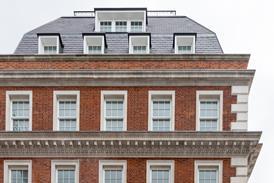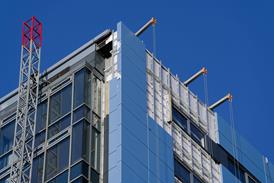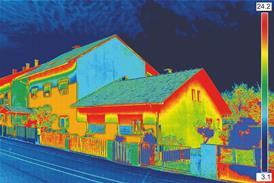They deserve more attention. According to the Centre for Sustainable Construction at BRE, flooring finishes in a typical office can contribute up to a third of the total environmental impact of a building over a 60-year life (assuming a five-year replacement interval and a standard wool/nylon mix carpet with a foam backing) – more than the roof, floor structure and walls put together (see right).
Soon manufacturers, architects and clients will have to examine the environmental performance of their floor specification more closely. Government legislation, rising landfill tax and demands from insurers and shareholders for greener, healthier buildings will force specifers to choose their floor coverings more carefully.
Some architects are already using environmental performance criteria for specification, such as BRE's Ecopoint system (see page 9). For example, London-based architect Architype carries out an environmental audit on all the materials it uses and aims to specify flooring with as low an environmental impact as possible (see case studies).
Manufacturers are also beginning to offer specifiers more sustainable options. BRE has just certified an environmental profile for Milliken Carpet and the commercial manufacturer is using this information to reduce the impact of its products and manufacturing processes on the environment.
It is also offering retextured carpet tiles to its European customers in a scheme called Earth Square. This aims to extend the life of a carpet, including its backing, by up to 20 years in order to save manufacturing resources and keep carpets out of landfill sites. Milliken's customers include Foster and Partners and the Environment Agency, which used retextured carpet at its offices in Cardiff (see "Tiles with air miles", page 10).
Milliken development director Dr Bill Tippett says that by the end of the year it will be as cost effective for its customers to return used carpets back to Milliken as it will be to dispose of them in a landfill.
The government's 1998 landfill tax is one of the main E E reasons large companies are now considering recycling. In 1998 a tax of £10 a tonne was introduced with an escalation of £1 a year to £15 in 2004/5. This is on top of the disposal costs of £20 a tonne. As a result, Tippett says he is getting increasing numbers of enquiries from corporate customers who wish to dispose of their carpet through Milliken.
Another commercial carpet company claiming green credentials is DuPont Antron, which has introduced a tool to measure the sustainability of its flooring. The Total Environment Impact Index takes into account factors such as emissions, health and safety, and water use and DuPont says it will use it to assess how it can improve the environmental performance of its nylon carpets.
Carpet maker Interface also has a green carpet scheme, called Evergreen Lease. Interface accepts responsibility for the maintenance and selective replacement of damaged tiles, which it claims prolongs the lifetime of the carpet.
Future legislation from the European Union will have an affect on the flooring specification. Certain types of PVC (vinyl) flooring are likely to come under the EU spotlight in the next few years when a new European chemical act demands that manufacturers justify some of the chemicals used in their products or replace them with less harmful materials (see "As green as grass?", overleaf).
Currently the amount of green flooring specification is largely confined to public-sector pilot projects and one-off private houses – but there are signs that the corporate interest in the market is growing. GlaxoSmithKline has taken part in Milliken's Earth Square scheme (see "Tiles with air miles") and Canary Wharf has expressed an interest in carpets with a low environmental impact.
Developer Taylor Woodrow, meanwhile, is experimenting with sustainable modern flooring in its Green Building in Macintosh Village, Manchester. The building has 32 flats, a nursery and a doctor's surgery and will contain plywood Wisa flooring from Finnish supplier Schauman Wood.
The specifation of natural flooring is a trend that seems to be catching on among housebuilders. Copthorn Homes chose a natural sisal carpet for an apartment block in Penge, south London, at the suggestion of Construction Resources, an ecological building merchant that has spent years trying to get the sustainable message across to architects and builders.
The following case studies demonstrate some of the challenges faced by a specifier trying to build with green flooring materials, and there are also details on the first project in the UK to use retextured carpet tiles. Read on …
Treading softly: Claycots Primary School
Claycots Primary School in Slough proves how difficult it can be to specify sustainable flooring even when the client has a green agenda. Slough council wanted a school that would provide a sustainable template – but although architect Architype was able to use Forest Stewardship Council-certified timber, a recycled aluminium roof and recycled newspaper insulation, it wasn’t able to tick all the boxes labelled sustainable flooring. The architect was able to specify natural linoleum for the 11 new infant classrooms. It was slightly more expensive than the alternatives, but Architype was able to persuade the school and contractor that it was worthwhile because of its better environmental credentials. Elsewhere, however, cost constraints and practical considerations meant nylon carpet and PVC flooring was used, which have a larger environmental impact according to BRE’s Ecopoint rating system. Local authority guidelines designed to protect children were responsible for some of the specifications: the client insisted on vinyl in bathrooms and toilets because of its non-slip attributes. In the classrooms that had sinks, the client was concerned that children could slip on the linoleum if it got wet. Architype had to ask linoleum supplier Forbo-Nairn to provide evidence that the covering would provide enough grip. “We’ve been supplying linoleum for 15 years and never had any problems,” says director Bob Hayes. “I think the client was being careful because it was afraid of being sued if there was an accident.” Carpet made from man-made fibres was supplied for the shared areas and some classrooms. “We wanted to specify an eco-carpet,” says Hayes, “but we went for a low-cost option because the head teacher was worried about the stains created by chewing gum and vomit. Schools would rather get a low-cost man-made fibre carpet that can be thrown away after five years rather than specify a better one that would last 25.” Hayes reckons a lot of schools subscribe to this way of thinking because they now control the purse-strings, rather than the local education authority. “The flooring now comes out of the same budget as the books,” he sighs. It’s also harder to specify sustainable materials with a design-and-build contract, says Hayes. “In some cases, the products aren’t necessarily any more expensive – it’s just the uncertainty that contractors don’t like. They’ll whack on a premium for the perceived risk without even looking at the material.” Hayes also remarks that main contractors tend to charge more if they can’t use their normal suppliers, as they aren’t able to use their purchasing power. Hayes says he was happy with Architype’s flooring specification, considering the cost constraints. The architect is currently working on the specification for the Eveline Low School in Southwark, south London. As the project is a green pilot scheme and involves the Department of Education, Hayes is hoping that more sustainable specifications will be accepted by the school and contractor. Suppliers:Carpets Heckmondwike Spacord, Gradus Carewise
Vinyl Altro Walkway non-slip vinyl
Linolium Forbo-Nairn Marmoleum Real/Dual
Back to nature: Walsingham Lodge, Barnes, London

Carpets (including underlay and adhesives) Construction Resources
Vinyl Altro Walkway non-slip vinyl Healthy living
Architype architect Catherine Harrington says the firm looks closely at the environmental performance of every material it uses. As well as using the BRE Ecopoint system to measure the impact of materials on the environment, Harrington has also devised additional criteria that consider the health affects of using a particular material. Harrington is looking at the consequences for health during the four stages of the product’s life: manufacture; construction and installation; in-use and occupation; and disposal and re-use. Areas that may come under consideration will include toxins released during fires, off-gassing (the emission of gases during use), and the ability of the material to biodegrade.
Substructural flooring systems
This is an example of one of the flooring types covered by BRE’s Ecopoint system. The best Ecopoint ratings for substructural floor systems have a relatively high environmental impact because they have to be engineered to take the weight of partitions, furniture and staff. The two raised floor systems have the highest overall embodied environmental impact. If the services were located in walls or ceilings, they would have a lower impact because the building would not require additional structural floors.As green as grass? Floor covering credentials
PVCPVC (polyvinyl chloride) is often used as a floor surface because it is inexpensive and easy to clean. The manufacture of vinyl is expected to be affected by forthcoming European Commission legislation, which aims to reduce the extent of harmful chemicals in the environment. Implementation will begin with the publishing of a list of “Chemicals for Priority Action” in the next two years. Manufacturers will have to justify the use of these chemicals in their products. Materials often used in the manufacture of PVC likely to be on the list include lead, cadmium, organotins and phthalates. If they can’t be justified, the EC proposes that less harmful materials should be used in PVC manufacture. Soft floor coverings
The Green Guide to Specification identifies those coverings requiring the least industrial processing as the best environmental performers. These include natural fibres such as sisal, jute, seagrass and wool. The worst are carpets with sponge or foam underlays and backings. A number of recent reports, including one by the University of Southampton, suggest that dust mites harboured in carpets cause asthma. This has been refuted by the Carpet Federation, which says asthma is just as likely to occur in countries where smooth flooring is more popular than carpet. Wood flooring
Surprisingly, many architects are still specifying exotic hardwoods when they could be using European timber from sustainable forests. Look out for wood certified by the Forest Stewardship Council and Pan-European Forest Certification. For installation solvent-free or low-emission finishes and adhesives are available. Natural linoleum
Linoleum is made from renewable material such as linseed oil, resin from pine trees and cork, which is mixed together with inorganic fillers such as clay and chalk. Expected lifespan is between 30 and 40 years. Natural rubber
A renewable source of flooring produced from the rubber plant. Durable and good at absorbing sound.
Tiles with air miles: The Welsh Environment Agency

Downloads
Relative impact ranges for interior elements
Other, Size 0 kb
Floor coverings
- 1
- 2
- 3
- 4
 Currently reading
Currently readingTread carefully …
- 5























No comments yet